AI is rapidly transforming the gaming landscape, moving beyond simple programmed behaviors to create richer, more dynamic, and personalized experiences for players. From smarter non-player characters (NPCs) to procedurally generated worlds and enhanced game testing, artificial intelligence is revolutionizing how games are developed and enjoyed. This evolution promises to push the boundaries of interactive entertainment and offer unprecedented levels of immersion and engagement.
The Rise of Intelligent NPCs
Smarter Opponents and Allies
AI is no longer limited to predictable, repetitive actions. Modern games leverage AI to create NPCs that exhibit more realistic behaviors, learn from player interactions, and adapt their strategies accordingly.
- Adaptive AI: NPCs can analyze player behavior and adjust their tactics, making gameplay more challenging and rewarding. For example, in a stealth game, enemies might learn to anticipate common hiding spots or adjust patrol routes based on player movement patterns.
- Realistic Interactions: AI enables NPCs to engage in more nuanced conversations and exhibit a wider range of emotions, creating a more immersive and believable world. Games like The Last of Us Part II demonstrate impressive NPC behavior, with characters exhibiting believable fear, grief, and loyalty.
- Team Dynamics: AI can manage complex team dynamics, allowing NPCs to work together effectively in combat or cooperative scenarios. Consider how in Left 4 Dead, the AI Director dynamically adjusts zombie spawns and enemy types to create a constantly evolving challenge for the player team.
Improving Player Engagement
Intelligent NPCs directly enhance player engagement by offering more dynamic and meaningful interactions within the game world. This contributes to a more captivating and memorable gaming experience.
- Personalized Storytelling: Some games use AI to tailor the narrative based on player choices and interactions with NPCs. This can lead to branching storylines and unique character arcs, providing a greater sense of agency and investment in the game world.
- Dynamic Challenges: AI can adjust the difficulty of encounters in real-time, ensuring that players are constantly challenged without becoming overwhelmed. This dynamic difficulty scaling keeps players engaged and motivated to improve their skills.
- Creating Believable Worlds: The improved realism offered by sophisticated AI makes the game world more believable and immersive, drawing players deeper into the experience. Players are more likely to invest time and effort in a game world that feels alive and responsive.
Procedural Content Generation (PCG) Powered by AI
Automating Level Design
AI-driven PCG is revolutionizing level design by automating the creation of vast and varied game environments, significantly reducing development time and costs.
- Generating Unique Landscapes: AI algorithms can create diverse landscapes, including forests, mountains, cities, and dungeons, with minimal human input. No Man’s Sky is a prime example of a game that utilizes PCG to generate billions of unique planets, each with its own flora, fauna, and resources.
- Designing Dungeons and Buildings: AI can generate complex dungeon layouts and building interiors, populating them with enemies, traps, and loot. This allows developers to quickly create a large number of unique environments without the need for manual design.
- Streamlining Asset Creation: AI tools can assist in the creation of textures, models, and other assets, further streamlining the level design process. AI-powered image generators like Midjourney and DALL-E 2 can be used to create unique textures and concept art for game environments.
Benefits of AI-Driven PCG
The benefits of using AI for procedural content generation are numerous, impacting both game development and player experience.
- Reduced Development Time: PCG can significantly reduce the time required to create game content, allowing developers to focus on other aspects of game design, such as gameplay mechanics and narrative.
- Increased Content Variety: PCG allows for the creation of vast and diverse game worlds with an almost unlimited amount of content. This ensures that players always have something new to explore and discover.
- Cost-Effective Content Creation: By automating the content creation process, PCG can significantly reduce the cost of game development.
AI in Game Testing and Quality Assurance
Automating Testing Processes
AI is increasingly being used to automate game testing processes, identifying bugs and issues more efficiently and comprehensively than traditional manual testing methods.
- Automated Bug Detection: AI agents can be trained to play the game and identify bugs, glitches, and other issues. These agents can explore the game world, perform various actions, and report any anomalies they encounter.
- Performance Testing: AI can simulate a large number of players to test the game’s performance under heavy load. This helps developers identify and address performance bottlenecks before the game is released.
- Regression Testing: AI can automatically perform regression testing to ensure that new features or bug fixes do not introduce new issues.
Improving Game Quality
The use of AI in game testing leads to a significant improvement in game quality, resulting in a more polished and enjoyable experience for players.
- Faster Bug Fixes: By automating the bug detection process, AI allows developers to identify and fix bugs more quickly, reducing the number of issues that make it into the final product.
- Enhanced Stability: AI-powered performance testing helps ensure that the game runs smoothly and reliably on a variety of hardware configurations.
- Better Player Experience: A higher-quality game results in a more enjoyable and engaging experience for players, increasing player satisfaction and retention.
AI-Powered Player Analytics and Personalization
Understanding Player Behavior
AI enables developers to gather and analyze vast amounts of player data, providing valuable insights into player behavior, preferences, and engagement patterns.
- Tracking Player Actions: AI can track player actions, such as movement patterns, combat strategies, and item usage, to understand how players interact with the game.
- Analyzing Player Feedback: AI can analyze player reviews, forum posts, and social media comments to identify areas where the game can be improved.
- Identifying Player Churn: AI can predict which players are likely to stop playing the game, allowing developers to take proactive steps to retain them.
Personalizing Game Experiences
By leveraging player analytics, AI can personalize the game experience to meet the individual needs and preferences of each player.
- Dynamic Difficulty Adjustment: AI can adjust the game’s difficulty in real-time to match the player’s skill level, ensuring that they are always challenged without becoming frustrated.
- Personalized Content Recommendations: AI can recommend content, such as quests, items, and characters, that are relevant to the player’s interests and play style.
- Adaptive Tutorials: AI can tailor the tutorial experience to the player’s learning style, ensuring that they understand the game’s mechanics and can quickly become proficient.
Conclusion
AI is undeniably transforming the gaming industry, impacting everything from NPC behavior and level design to game testing and player personalization. As AI technology continues to advance, we can expect to see even more innovative applications emerge, pushing the boundaries of interactive entertainment and creating richer, more engaging, and personalized gaming experiences for players around the world. Embracing AI in game development is no longer a futuristic concept, but a strategic necessity for creating cutting-edge games that resonate with modern players.



